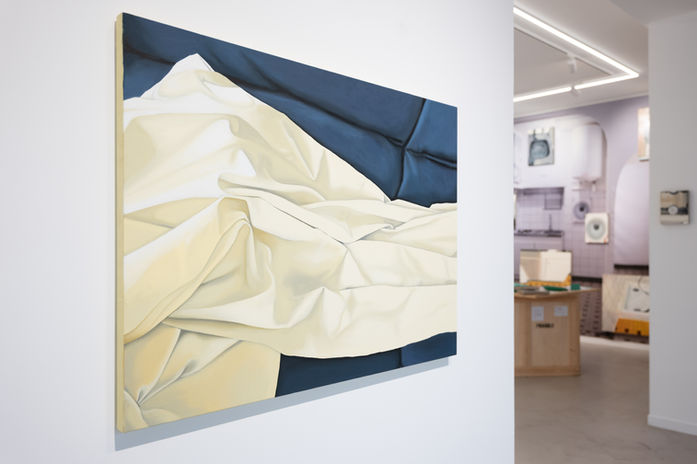SAM KRACK
Traces de vie
30 November 2023 until 06 January 2024
‘Traces de vie’ presents the work of luxembourgish artist Sam Krack (*1993), living and working in Sète (FR). Sam's work is a succession of shifts that challenge the viewer's perception and provide clues to understanding the creative process. Thus the snapshots of an online ad become the subjects of his oil paintings. A curtain changes its functionality to become the canvas of a painting. And the catchy title of an ad becomes the title of a work. In search of a spontaneous and sometimes clumsy gesture when photographing, the ad sites are for Sam the rare spaces where we can still escape from a staged, controlled and somewhat dehumanized daily life. Three different series of works are presented.
Sam Krack has studied Fine Art at ‘Ecole Supérieure des Beaux Arts de Montpellier’, in Montpellier, France. His work has been exhibited at MO.CO Panacée & Musée Fabre in Montpellier, FR; LIAR, New York, USA; Canal royal, Crac Occitanie, Sète, FR and Centre Photographique, Marseille, FR, amongst others.
About the different series:
Etat des lieux - ARTEMIS, 2020 - 2023
Sam Krack moves into his apartment in 2019. An inventory of fixtures is drawn up by the real estate agency. This exploration of a place, in search of traces of life that can be described in an almost painterly way - "chipped on the side, impressions of filling inside and out, yellowed, crinkled, rough joints" - is the starting point for a meta-work that will develop over three years.
This exercise reflects many of the artist's preoccupations: an interest in the modest and the insignificant, the ambiguity of trompe l'œil, the power of paint to change the status of an image, the notion of protocol that codifies our daily practices, the "mise en abyme" of reality in his image...
Sam Krack creates paintings of images that bear witness to the state of his premises. A total of 18 canvases were created for this display of the official documentation (état des lieux). For the exit inspection two years later, the paintings were hung in the apartment, close to the marks of life visible on the walls, doors, sinks and cupboards. Today, the apartment is occupied by someone else.
The paintings are stored in a crate. The agency's inventory of fixtures accompanies them. The apartment is in a box, and the crate is a potential, mobile exhibition in itself, to be opened out and interpreted.
— Text by: Pauline Faure, Curator at MOCO Montpellier
Rideaux (Décoration), 2022
"For the 'Rideaux (Décoration)' series, I paint photos of curtain advertisements found on an amateur online sales site in oil on the curtain itself. The curtain becomes the medium of its own image, and remains visible as a memory on the edge. The size of the curtain determines the format of the canvas. The title is given by the description of the curtain in the ad. Using "poor" images as raw material, I deconstruct the visual flow through a succession of displacements: from the screen and interface to the pictorial surface, from the world of media to that of painting, and from information to silence.
Translation in painting contrasts slowness and subjectivity with the triviality of source images. Affirming slowness in an age of speed and short time becomes a kind of resistance, a political will. In this sense, I use painting to consider my pieces within the cultural fabric from which they emerge. It becomes a tool for questioning the gaze, photograpy and its hold on our relationship to the world. Above all, painting allows me to better dissect the world of appearances."
— Text by Sam Krack
MONOBLOC, 2022
« ‘Monobloc’ is an installation of three white earthenware sculptures. I cut a plastic garden chair into 8 pieces to make plaster molds to reproduce it in ceramic. In this way, I extend the gesture I usually accomplish in my paintings to the sculptural level. The fragility of ceramics and the complexity of their manufacture subvert the characteristics of these ordinary, inexpensive chairs. Stacked one on top of the other, the two chairs nevertheless retain some of the functionality of their model. » — Sam Krack
[...] The poetization of the commodity accompanies a thinking of the object whose artistic transformation tends to resist the temporality of simple consumability. Sam Krack's installation "Le sinistre" is a mischievous expression of the quest for eternity that is inherent in the sacralization of the work of art. Composed of two garden chairs reproduced in white earthenware, the plastic debris of one of these same chairs, and five canvases, the piece was born out of a sinister incident that occurred to his previous work, "Monobloc (Salon de jardin)", which was exhibited in a museum and destroyed by a visitor who had been fooled by the faithful transcription of the object reduced to its function of use: the installation hijacked, by refining it in a fragile material, one of the cheapest, most standardized seats, the attribute par excellence of a country life reduced to a piece of garden. A reversal of the original work is achieved by reworking the ceramic debris into plastic, returning the chair to its original material. This process, combined with the reproduction in paint of the documentary photographs needed for insurance reports, mimics the procedures of filing and memorizing administrative events, testifying to a laborious and slow, almost absurd, exercise in artistic resistance to the brevity of matter.
— Text by: Maud Marron-Wojewodzki Conservator at Musée Fabre, Montpellier, FR








